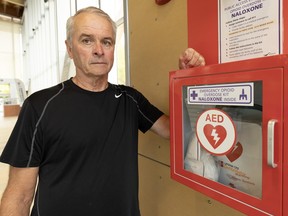Health
B.C. Schools Required to Implement AEDs, Naloxone Amid Funding Concerns

All schools in British Columbia are now mandated to equip themselves with automated external defibrillators (AEDs) and naloxone kits to address heart attacks and drug overdoses. This directive, announced by the provincial Education Ministry, has been met with frustration from cash-strapped school districts that feel the initiative lacks adequate financial support.
Surrey Schools chairman Gary Tymoschuk expressed his concerns, stating, “We’re not too thrilled about this. It’s a great initiative… but we were hoping we would see the funds to go along with that.” The Surrey district has already outfitted its 21 secondary schools with AEDs and naloxone kits. However, it now faces the challenge of sourcing approximately $2,000 for each of its 105 elementary schools to purchase the necessary equipment.
In a policy shift this summer, the Education Ministry set a deadline for all high schools in B.C. to have AEDs and naloxone kits by the end of 2025. Elementary schools are expected to meet this requirement by September 2026. The curriculum for Grade 10 students will also include training on how to use these devices and perform CPR.
This initiative follows pressure from both students and parents after incidents highlighted the urgent need for such equipment in schools. Notably, students at Point Grey Secondary School were unable to locate an AED when a classmate suffered a cardiac arrest. Similarly, parents of a University of Victoria student who did not receive timely medical assistance after an overdose have advocated for these changes.
Vancouver school board trustee Suzie Mah confirmed that all secondary schools in her district will have AEDs by September 2025. Naloxone kits are also expected to be distributed this fall, costing approximately $35 each. While Mah supports the inclusion of these life-saving devices, she voiced disappointment over the ministry’s rejection of a $250,000 request for defibrillators and an additional $50,000 for their maintenance. Due to budget constraints, the board must divert funds from student services to acquire the AEDs.
In response to inquiries about funding, Education Minister Lisa Beare indicated that historically, first-aid equipment has been purchased through operational funding. She noted that school boards could utilize mental health grants to help cover costs for naloxone. Beare emphasized that it is the expectation of the ministry that all districts will meet the equipment deadline, with any difficulties addressed on a case-by-case basis.
Some districts, including those in Burnaby, Richmond, North Vancouver, and West Vancouver, already have AEDs in select schools. Surrey previously installed AEDs in every high school in 2019 following advocacy from the mother of a teenager who suffered a cardiac event. Tymoschuk highlighted that trained first-aid attendants in schools routinely check the functionality of these devices.
Although training for staff on how to use AEDs and naloxone is a concern, Beare stated that the B.C. Centre for Disease Control has provided guidance on training opportunities. Furthermore, free online training for naloxone is available.
Former Vancouver police inspector Ken Frail suggested that the government should have established provincewide guidelines for the placement and use of these devices. He advocated for a cohesive approach, noting that Richmond City Hall effectively installed AEDs and naloxone kits in easily accessible, well-labeled locations. He argued, “This is the opportunity to say: ‘Let’s do this consistently. Let’s do this in every school.’”
Frail, who has witnessed overdoses in public areas without the presence of naloxone, collaborated with local officials to ensure that the kits are readily available alongside AEDs in civic buildings. He expressed satisfaction with this initiative, stating, “I am so pleased with the way they’ve done that, but it should not have taken that long to promote a public safety thing.”
As B.C. schools prepare to implement these life-saving measures, the ongoing discussions about funding and training underscore the challenges faced by districts in balancing safety and budgetary constraints. The provincial government’s commitment to improving school health and safety will be tested as these new requirements come into effect.
-

 Science2 months ago
Science2 months agoToyoake City Proposes Daily Two-Hour Smartphone Use Limit
-

 Health2 months ago
Health2 months agoB.C. Review Reveals Urgent Need for Rare-Disease Drug Reforms
-

 Top Stories2 months ago
Top Stories2 months agoPedestrian Fatally Injured in Esquimalt Collision on August 14
-

 Technology2 months ago
Technology2 months agoDark Adventure Game “Bye Sweet Carole” Set for October Release
-

 World2 months ago
World2 months agoJimmy Lai’s Defense Challenges Charges Under National Security Law
-

 Technology2 months ago
Technology2 months agoKonami Revives Iconic Metal Gear Solid Delta Ahead of Release
-

 Technology2 months ago
Technology2 months agoSnapmaker U1 Color 3D Printer Redefines Speed and Sustainability
-

 Technology2 months ago
Technology2 months agoAION Folding Knife: Redefining EDC Design with Premium Materials
-

 Technology2 months ago
Technology2 months agoSolve Today’s Wordle Challenge: Hints and Answer for August 19
-

 Business2 months ago
Business2 months agoGordon Murray Automotive Unveils S1 LM and Le Mans GTR at Monterey
-

 Lifestyle2 months ago
Lifestyle2 months agoVictoria’s Pop-Up Shop Shines Light on B.C.’s Wolf Cull
-

 Technology2 months ago
Technology2 months agoApple Expands Self-Service Repair Program to Canada









